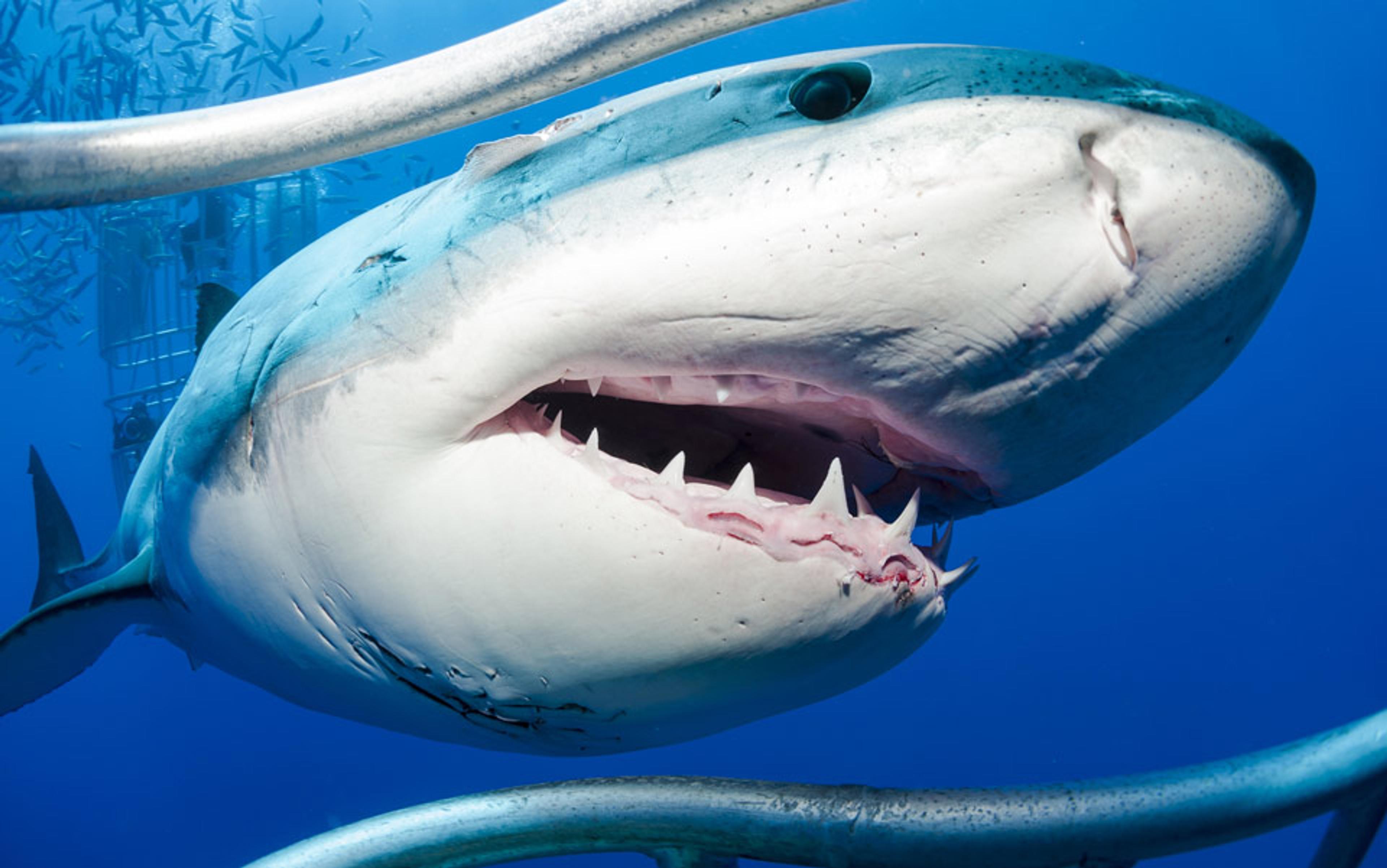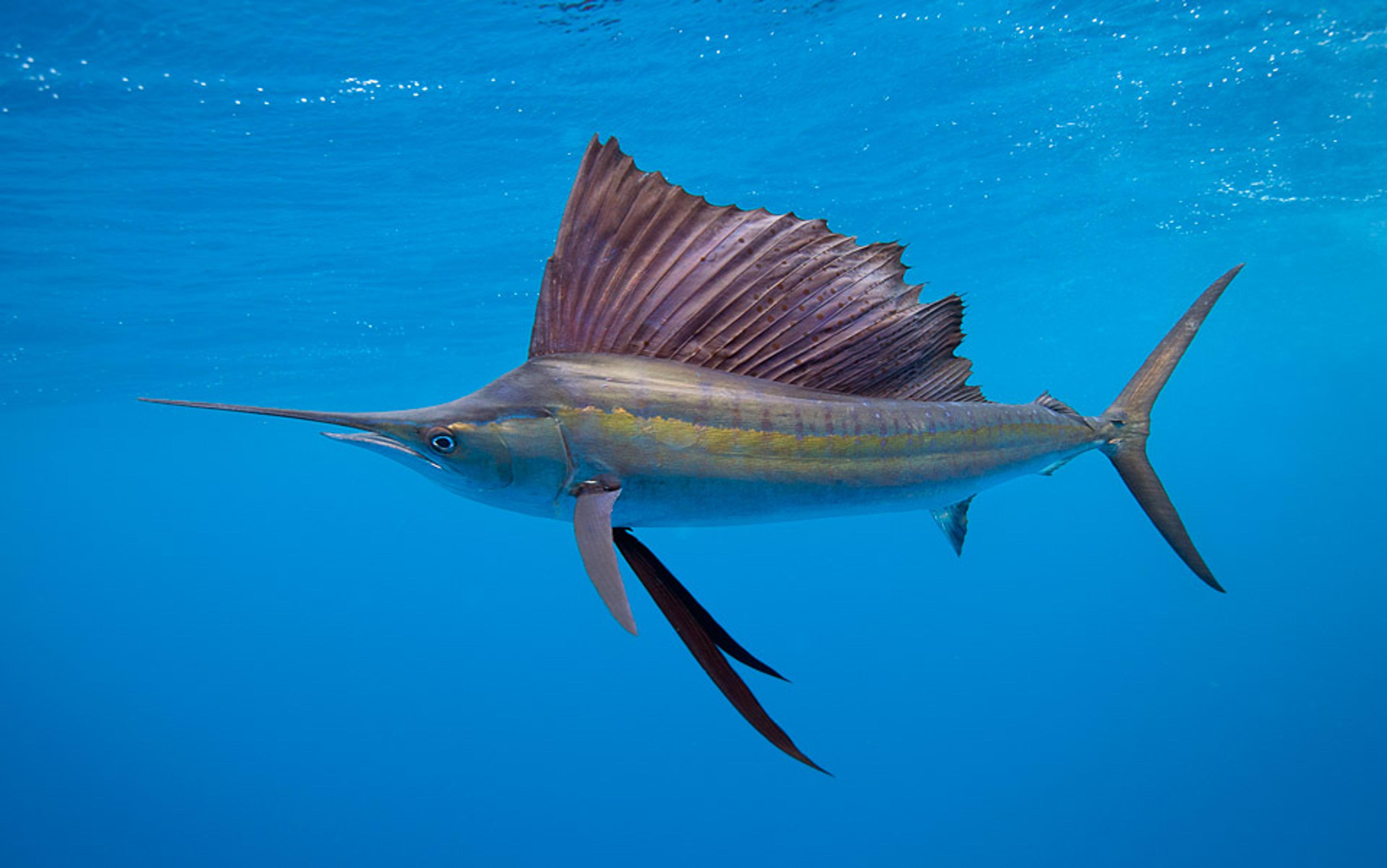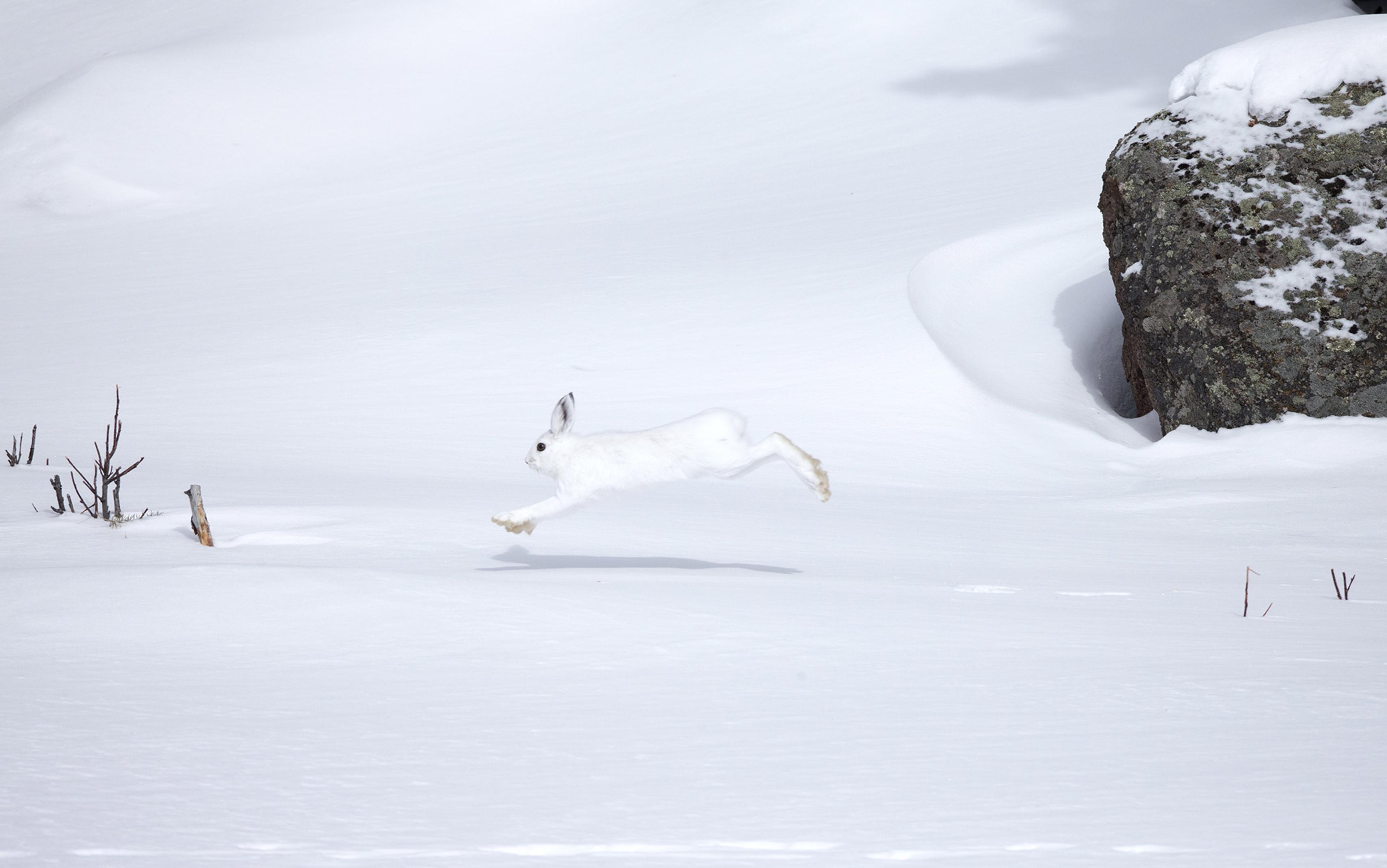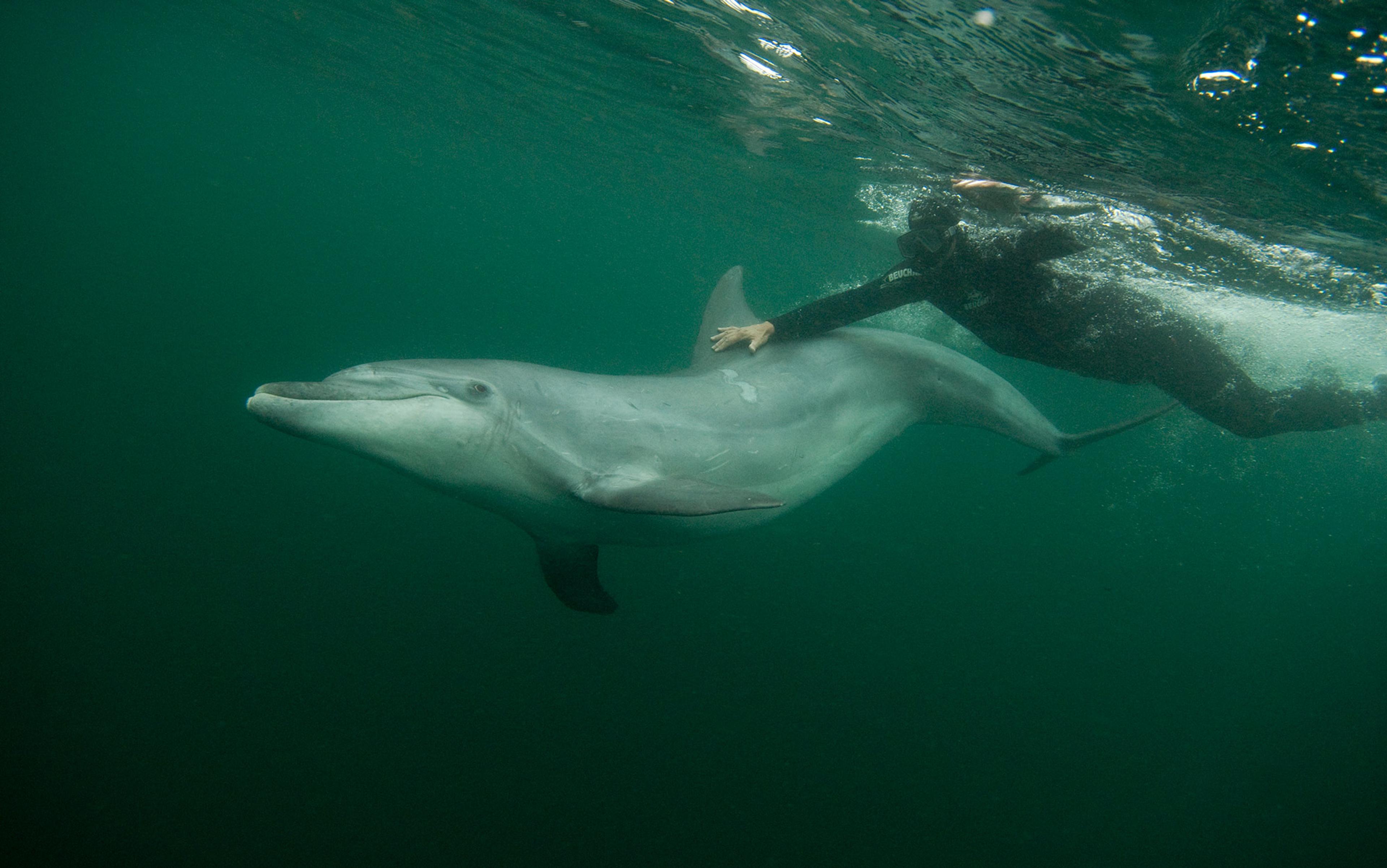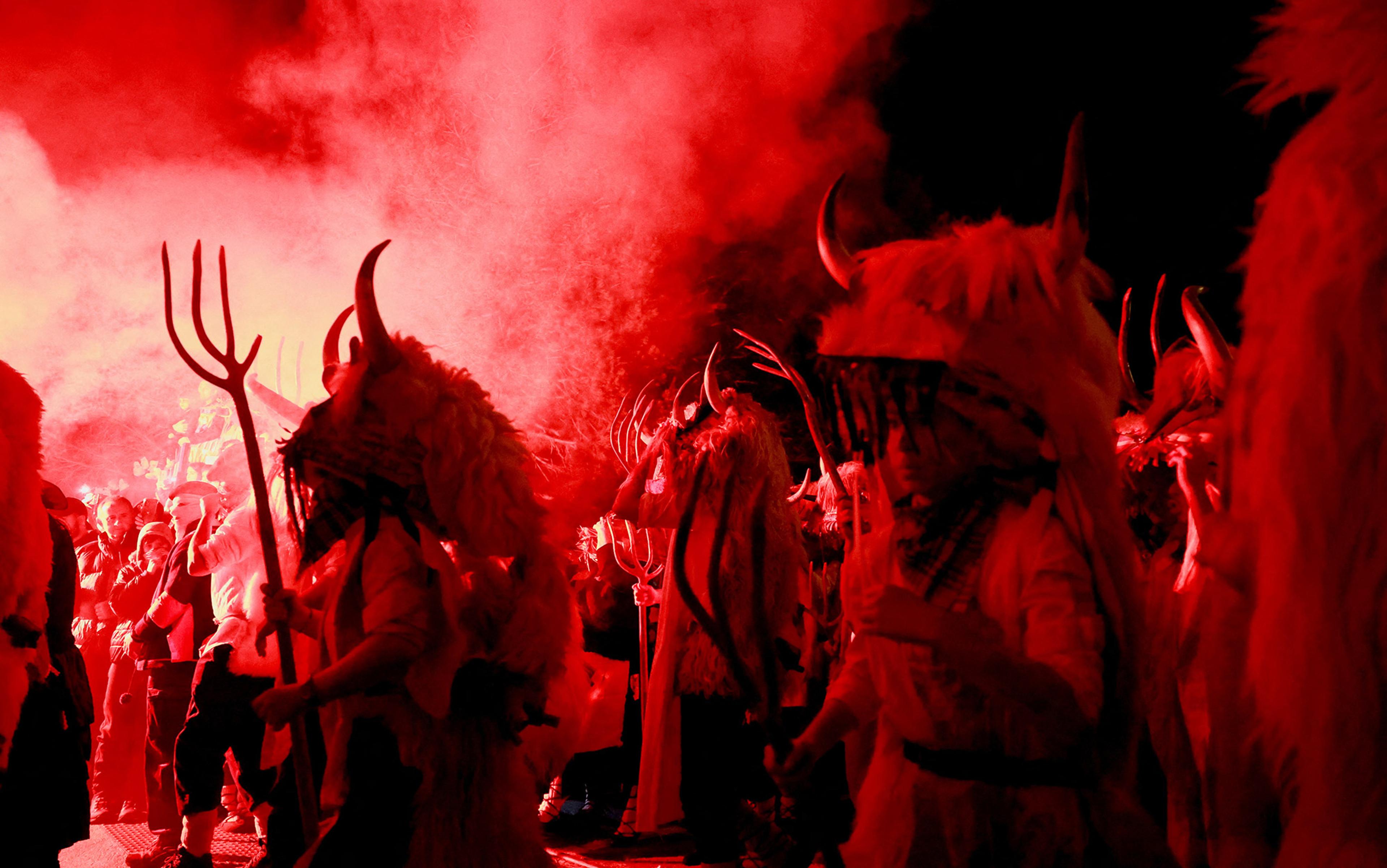The safety briefing started just as we dropped anchor. ‘Welcome to Guadalupe Island,’ our divemaster announced, ‘the best place on the planet to see great white sharks.’
Most people don’t particularly want to see great white sharks – deterred, perhaps, by the 300 razor-sharp, serrated teeth with which the great fish easily shears the head off an 8,000 lb bull elephant seal. Fewer still want to get in the water with them. But that’s exactly what I and my 20 companions were going to do here in the clear waters off this volcanic island, 250 miles south of San Diego. We’d come to dive with the most feared oceanic predator in the world.
To do so, as our divemaster explained, we’d enter underwater cages. Submerged to a depth of 8 to 20 ft, stabilised by weights on our ankles and 40 to 50 lbs strapped to our chests, we’d stand on the metal mesh of the cage bottom while breathing through regulators hooked up to the ship. Meanwhile, ‘shark wranglers’ on the ship’s deck would entice them toward us with tuna. We’d be combining three of humanity’s common fears – enclosed spaces, the possibility of drowning, and the world’s largest predatory fish – to produce an experience for which we were eager to travel hundreds of miles and pay thousands of dollars.
Why? Friends offered a simple explanation: we’re crazy. But a more intriguing answer is suggested by a new understanding of how the brain processes fearful stimuli. People such as me illustrate a fascinating paradox: in us, the physiology of fear relates not just to pain and phobias, but also to motivation, sex, pain relief, and love.
Fear, like pain, is not something anyone wants. And yet fear protects us more effectively than the most doting mother. ‘Fear is a survival mechanism,’ points out the psychiatrist Mohammed Milad, director of the Behavioral Neuroscience Laboratory at Massachusetts General Hospital in Boston. ‘Fear in some instances is a good thing.’
Fear helps us avoid danger – such as drowning, getting stuck in tight spaces, or getting eaten by sharks. It’s easy to see why some common fears arose. In Africa, where humans evolved, many snakes and spiders are dangerous; lions and other predators hunt our kind at night; and even today, our close relatives, the gibbons, frequently injure themselves falling from trees. No wonder that in 2001 a Gallup poll found that, even though the US is blessed to have few poisonous snakes, 51 per cent of respondents feared them above all else. Fear of spiders is so common that there is now an iPhone app, recommended by the British National Health service, that features a cute cartoon arachnid to help people overcome their phobia. Nearly all children begin to fear the dark around age two. More than a third of Americans and well over half of Brits confess to a fear of heights, according to the latest Gallup and YouGov surveys, respectively.
Learning to fear happens not only in the thinking part of the brain – as in ‘Oh no, here comes a dog who might bite me like one did last year’ – but in its ancient, unthinking core. Consider what happens when most people see a snake: in as few as 20 milliseconds – faster than you can think – the visual stimulus is relayed to the amygdalae, two roughly almond-shaped structures deep in the oldest part of the brain, where unconscious emotional memories are stored. The amygdalae then send information about the threat along two paths. The slower path is more considered: is it a snake, or just a piece of rope? If a snake, is it poisonous, or a harmless garter? These questions are answered in the prefrontal cortex in about 300 milliseconds, and can override or turn off the initial response of the amygdala. But already, the faster path has taken action.
In response to threat, the body releases a potent cocktail of more than 30 chemicals, including the well-known stress hormones adrenaline and cortisol, to cope with danger. Heart rate increases. Veins constrict. Blood glucose soars. Pupils dilate, muscles tense, palms sweat. Additional oxygen is shunted to the lungs, and non-essential systems such as digestion shut down. For millennia, these physiological, unthinking changes helped our ancestors sharpen senses, prime reflexes, dull pain, increase strength and enhance mental focus – preparing the body to fight or escape from enemies.
But, as effectively as these responses might have once helped us cope with everyday dangers, today they’re seldom necessary. Westerners are more than nine times more likely to die from a lightning strike than from a snakebite. More people are killed each year by malfunctioning toasters than by sharks. Yet some people still actively court the chemical kick that our most ancient fears provide, as I would soon discover on my shark expedition.
Here’s the part of the safety briefing that really caught our attention. ‘If the shark gets in the cage,’ our divemaster began – and our ears perked up - ‘stay away from the mouth and the teeth,’ he counselled wisely. Also, he noted: ‘You may have to get out of the cage.’
The adventure gene codes for dopamine, which one scientist dubbed ‘the Kim Kardashian of neurotransmitters’
‘Awesome!’ said one man in our group, a body-builder and heli-skiier. If a shark outside the cage was cool, one actually in the cage would be even cooler! My companions seemed disappointed to learn that a shark had only once got into a dive cage off Guadalupe (due to a shark wrangler’s error; nobody was hurt, and the shark was released unharmed). Alas, we were unlikely to experience such an event.
On our vessel, as one of four women among 17 men, I was surfing a tsunami of testosterone. These guys flew airplanes, rode motorcycles, sky-dived. Some had run with the bulls in Spain and hunted big game in Africa. One was a locomotive engineer so tough he had actually survived being run over by a train. Many said diving with sharks was on their bucket list of experiences that would give them a rush.
The guys exactly fit the profile for what the psychologist Marvin Zuckerman at the University of Delaware dubbed the ‘high sensation seeker’ personality – also known as Big T. (Though the trait is more common in men, the T stands for thrill, not testosterone.) Big T people love novel experiences and extreme sports. In lab experiments in which participants are shown emotionally arousing images – mild erotica, a snake poised to strike – Big Ts show high activity in the area deep in the brain known as the insula, an ancient gateway where visceral sensations, such as taste and pain, are received. (Low sensation seekers, on the other hand, show increased activity in a different area, the anterior cingulate cortex, associated with regulation of emotion.) Ten studies, from the US, Japan, Germany, Israel and Finland, suggest a genetic difference among sensation-seekers too. Big Ts seem more likely to possess an ‘adventure gene,’ which codes for receptors for dopamine, a chemical related to adrenaline and dubbed ‘the Kim Kardashian of neurotransmitters’ by one scientist because of its long association with pleasure-seeking.
Are people like us shark-divers truly fearless? Not at all. To be utterly fearless, your amygdalae would be destroyed or disabled by injury or disease.
Big Ts, like all of us on the shark dive, have working amygdalae – whether they admit to feeling scared or not. ‘You might ask them if they’re nervous, and they’d say no,’ says Milad. ‘But their skin conduction report [which measures, among other things, nervous sweat] would say a different thing.’ Like anyone who is terrified, they are experiencing a rush of neurochemicals initiated by the amygdala’s interaction with the body’s nervous system and bloodstream.
But here’s the difference: they like it. Because fear can be exciting.
How can anyone like fear? ‘The body is a blunt instrument,’ says the neuroscientist Joseph LeDoux at New York University, who in the 1990s discovered the amygdala’s role in the unconscious learning of fears. ‘And fear is a social construct.’ In response to dangerous stimuli, ‘the body is moving blood around to muscles that need to respond a certain way. You could get the same rush from jogger’s high,’ he points out. Under acute stress, the brain releases endocannabinoids and opiods – natural pain-relievers that create the pleasant sensation runners enjoy and users seek with recreational drugs. And, LeDoux notes, there’s another kind of excitement that fear’s physiology mimics: sex.
‘If you could have sex with your wife right after you got mugged, it would be the best sex of your life’
That the line between desire and dread is sometimes blurred was illustrated in an experiment that took place in 1974 on a wobbly bridge over a 230 ft canyon in Vancouver. Men crossing the 450 ft Capilano Suspension Bridge met an attractive woman in the middle, who asked them to fill out a survey, then gave them her phone number in case they wanted to ‘talk further’. Half of the men ended up phoning, and the stories that they then wrote about crossing the bridge were filled with sexual imagery. But this was not true of another group of men who had encountered the same woman while crossing a sturdy ‘control’ bridge over a nearby rivulet. These results have been since replicated using both men and women as subjects, on rollercoaster rides and in the laboratory – and on many a date to watch a horror movie or ride a rollercoaster. LeDoux relates what his colleague, the psychologist Stanley Schachter, used to say to him: ‘If you could have sex with your wife right after you got mugged, it would be the best sex of your life.’
The physiology of fear and attraction, Schachter concluded, are so similar that we sometimes cannot tell them apart. In seeming paradox, wildly differing emotions can arise from the same areas of the brain and involve the same neurotransmitters. Consider dopamine. At the Affective Neuroscience and Biopsychology Lab at the University of Michigan in Ann Arbor, researchers injected it into rats, in the front of the brain structure known as the nucleus accumbens – of which, like its immediate neighbour the amygdala, there is one in each hemisphere. This caused mice to eat three times as much as normal – as expected, considering dopamine’s well-known role in sex and addiction. But injecting dopamine in the back of the nucleus accumbens caused rats to adopt a defensive posture, paws up, as if threatened by a cat. Disabling the transmission of dopamine, on the other hand, prevents the nucleus accumbens from initiating responses to either fear or rewards.
At the Dunbar Laboratory for Research on Memory and Fear that she leads at Northwestern University in Chicago, Jelena Radulovic got similar results with oxytocin, widely known as ‘the cuddle hormone’. Because oxytocin floods the mammalian brain during hugging, touching and orgasm, she reasoned that adding it to the brains of mice facing aggressive peers might attenuate their fear. But the opposite happened. The so-called cuddle hormone actually made the mice more fearful than they were before.
‘At first, it seemed paradoxical,’ she said. ‘But in this case, oxytocin improves social memory – whether the memory was good or bad.’ And this, she said, is emblematic of today’s new findings about the physiology of fear: ‘We are finding new circuits, we are finding brain areas not previously known to impact fear that do. As we are integrating the molecular and genetic research we have done in the past, we are finding that all these different emotional states and memory states are actually related.’
On board our shark-dive vessel, our brains were surely awash in neurotransmitters before we even got into the water. We were united in our excitement. In just minutes, we would meet the unknown. What does it feel like to be underwater, just feet away from a wild, adult, great white shark, a predator weighing more than a ton?
But what happened next showed just how varied and individual the human response to the same stimulus can be.
‘My teeth are chattering, I’m so excited!’ a 44-year-old mother of two whispered to me as we tugged on our wetsuits in preparation for the cage dive. Her childhood fascination with sharks had grown after seeing Jaws. ‘I was intrigued,’ she said, ‘because I thought, they can’t really be like that!’
She is right. Great white sharks are not aggressive toward humans. A great white would rather eat dead whales or live seals. Only rarely do they make the mistake of biting a person. When they do, they spit us out – which is why the majority of humans survive attacks from this enormous predator.
We knew we’d be in no danger in our shark cage; this consciously learned knowledge rested comfortably in the prefrontal cortex, the part of the brain that is capable of tamping down an unwarranted panic response initiated by the amygdala. But still, as my new friend’s teeth chattered, my own heart pounded.
Eight others had already descended into the water. Within a few minutes, the shark wranglers, tugging on the lines that held the tuna baits, had attracted the first great white, a 10 to 12 ft male whose toothsome mouth gaped wide as he lunged to grab the bait. On deck, we could see him perfectly in the clear water, fast and powerful as a torpedo. A deep, visceral cry, accompanied by fist pumps, went up from the men.
But it was another woman’s response to seeing the shark that most impressed me. She was a creative director at an ad agency; she told me she had loved sharks since she was a child. When, from the deck of the boat, she saw the great white, her arm shot out toward the creature and she cried: ‘There’s the be-be!’
It would be difficult to imagine a creature less babyish than an adult great white shark. And yet for many people – and I am one of them – the sight of any animal evokes feelings of tenderness. A small study published this October of 14 mothers at Massachusetts General Hospital found that MRI scans of their brains lit up in the same areas when shown pictures of their pets as when shown pictures of their children. Another larger Japanese study from 2012 reports that the brains of people function differently after being shown pictures of cute baby animals than after viewing pictures of tasty food. Those who saw baby animals performed tasks with greater focus, concentration and productivity.
But animals don’t have to be pets or babies to win my heart. I will approach just about any animal who will put up with me, a fact my parents noted before I’d turned two, when I escaped my mother’s grasp and toddled fearlessly into the hippo pen at Frankfurt Zoo in Germany.
I don’t remember this. But my amygdala does. Thinking that the brain area widely known as the ‘fear centre’ begins and ends with fear ‘taps into a broad misunderstanding of what the amygdala does’, according to LeDoux. What it really does, he says, is process the survival value of sensory stimuli. It is a repository not only for aversive unconscious memories, but also for positive ones. Throughout my life, animals have delighted me, fascinated me, comforted me, inspired me.
it’s not the danger I seek. It’s the animals – the joy of touching them, seeing them, being with them
This might explain why I don’t flinch when I pick up a wild pinktoe tarantula (a gentle species) in my bare hands, as I have done in French Guiana. I never blanched when, on an assignment working in a pit with 18,000 (harmless garter) snakes, the reptiles tried to warm themselves by crawling up my pant legs and into my shirt sleeves.
In fact, my reaction is usually the opposite. Once, without thinking, I leapt out of a moving truck in order to run toward and pet a 12 ft wild Burmese python. (This was a bad idea. They can and do attack and kill people, but this one only looked at me benignly as I stroked its tail.) Because most people fear these animals, and because women are especially fearful of snakes and spiders, I’ve acquired a reputation as a sort of Danger Girl. But it’s not the danger I seek. It’s the animals – the joy of touching them, seeing them, being with them.
Soon it was time to put on my dive mask, don the chest and ankle weights, take the regulator in my mouth and descend into the shark cage. My pulse ratcheted up again. It wasn’t panic. Only once before had I felt my heart pound this hard, and I will never forget the circumstances: it was years ago, when, after a long absence, I was getting off a plane, moments away from reuniting with the man I love.
Five minutes after I got into the cage, the first shark appeared. From 50 ft away, the blue sea seemed to separate into two layers, one grey and one white, and gather itself into the shape of a shark. The shark swooped toward us, like a shooting star falling from the night sky. Shaped like a torpedo, electric with power, and possessed of a liquid grace, no creature I had ever seen was more elegant than this. But the experience was not the least bit scary.
The shark came back again and again. Sometimes, he came close enough that I could have reached out to touch him. Once, I saw his black eye swivel in its socket and look right at me.
I spent three days cage-diving with the great whites. Responding to their grace reminds me of how I feel listening to music I love – during which the brain releases dopamine, particularly in anticipation of those moments of a song I most enjoy. The sharks’ beauty elicits in me the feeling of looking at great art. Brain researchers at New York University reported in 2012 that looking at paintings one enjoys engages at once the left medial prefrontal cortex, the left substantial nigra, and the left hippocampus – activating cognitive, emotional and memory circuits also known to be involved in fear.
But overall, the feeling that stays with me – and the one I can play back like a recording in my brain – is one that shocks my friends. Being in the water with great white sharks induced a sense of deep tranquility in me. Next time I face something really scary – like a doctor’s appointment or a big speech – I will think of sharks, calling on the ancient pathways and potent neurochemicals in my brain to calm me down.
